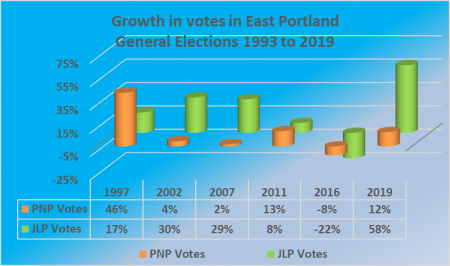 The PNP must abandon socialism or suffer a slow near death experience. Those persons within the party who are product of the heady days of the 1970 period will probably rubbish this view, but facts are pointing clearly in that direction.
The PNP must abandon socialism or suffer a slow near death experience. Those persons within the party who are product of the heady days of the 1970 period will probably rubbish this view, but facts are pointing clearly in that direction.
An analysis of voting pattern since the 1980s is very clear new voters are embracing the JLP in larger numbers than the PNP, the change started after the huge swing to the PNP in the 1970 with the enhanced focus on democratic socialism. Young persons out of school especially UWI, were mesmerized by Michael Manley’s oratory and charisma and overwhelmingly gave the PNP their full support. Back then, the PNPYO, the Social Development Commission and the National Youth Service programs were three of the top entities pushing the social agenda to young people.
Left with empty shelves and mass migration of the middle class, the children of the 70s and 80s have not embraced the PNP the way their parents did. Increasingly, the post 1960 children look to North America as the standard fueled by the advent of the ubiquitous Cable Television and computers beaming capitalistic policies daily.

Dr. Peter Phillips – President of the PNP
Today’s young adults many who are schooled in North America or spent several holidays there have no real love for Socialism and that is showing up in the voting pattern. In the 1970s the local stock market is estimated to have had around 10,000 investors owning stocks directly, today that number have climbed to well over 120,000 around 15 percent of the persons who voted in 2016, with younger persons flocking to the market like never before and this growth trend will continue. That is another example of the switch in the political landscape. Those are reasons why the voting pattern is showing the Labour Party increasing their vote tally sharply over the PNP. That trend shows up in the Eastern Portland election now and in the past. Although there were 2,000 new voters on the list than in 2016, the PNP only received around 25 percent to the JLP’s 75 percent.
Except for a few seats, the PNP is fast becoming a minority party. Up to the 1970s the party, dominated St James and St Ann areas that the JLP could only win 1 seat in each, now they hold a minority and where they win its marginal, except for Lisa Hanna’s seat. The picture is the same in St Mary, with the PNP having only one seat in that parish where they used to have two solid seats. They used to dominate the corporate area, but now primarily holds just the seats bordering on the waterfront, with the exception of two.
If the party does not radically change its policies, it will take a long time for them to swing the majority of young persons to support them in the long-term, by then a lot of their current support will pass on, thus reducing them to a minority party country wide.
Christopher Burns writing in Jamaica Observer after the 2016 elections set out a detailed assessment of the trends of voting between 1993 and 2016. The details are one that we of IC Insider wrote about some time ago and reported in Investors Choice.
Burns stated “a review of the voting pattern between 1993 and 2016 reveals a few interesting findings as far as votes for the PNP are concerned, vis-Ã -vis votes for the JLP. In the 1993 General Election, of the 678,572 votes cast, the PNP received 401,476 (59.2 percent) to the JLP’s 263,472 (38.83 percent).’ The PNP received 138,274 or 20.38 percent more votes than the JLP.”
“Over the six general elections (1993 – 2016) the PNP, in 2016, netted only 31,989 more votes than it did in 1993, while the JLP netted 173,500 more than it did in 1993.” “The PNP received high vote counts between 1993 and 2007, but “its highest vote performance in 2011, produced roughly 62,318 or 15.51 percent more votes than it did in 1993. However, even though the JLP lost the 2011 General Election, its 2011 vote performance produced 142,448 (54.07 percent) more votes than in 1993.”
“In the 2016 elections, the JLP received 436,972 votes, while the PNP secured 433,735, from the 2016 voters list of eligible voters that grew by 176,376 or 10.70 percent over 2011, the PNP received 30,329 (6.54 percent) fewer votes than it got in 2011. The JLP increased its 2016 votes by 31,052 (7.65 percent) over 2011.”
There are a number of developments that suggest that the Labour Party support has grown since 2016, while that of the PNP has not. The Eastern Portland seat by-election represented a 4.5 percent swing from the 2011 election results. The 2011 election is a better base to use than the 2016 results that went against the general swing of that election. Public opinion polls suggest that the current swing nationally, is much greater than 4.5 percent. The performance of the stock market, business and consumer confidence levels that are all at record highs, point to a margin that is in excess of what the swing is in East Portland based on the 2011 results.
The PNP needs to change strategies and many of its policies. It needs to be articulating a cohesive set of policies that can appeal to the younger generation and there are a series of issues that they can focus on that can set them apart from the JLP government.

 Looked at differently, he picked up just 354 votes more than in the 2011 elections or only 3.8 percent more. On a net basis, he garnered only approximately 25 percent of new voters, while Vaz got 75 percent. This is consistent with a pattern seen island wide since 1993 and is one that is not likely to change, anytime soon.
Looked at differently, he picked up just 354 votes more than in the 2011 elections or only 3.8 percent more. On a net basis, he garnered only approximately 25 percent of new voters, while Vaz got 75 percent. This is consistent with a pattern seen island wide since 1993 and is one that is not likely to change, anytime soon. 2016 elections, when the votes by the party sank by a hefty 22 percent and well against the national trend. The trend since the 1993 elections, suggests that the natural growth in party support should have seen them polling over 9,700 votes, just below the numbers she got in the latest polls.
2016 elections, when the votes by the party sank by a hefty 22 percent and well against the national trend. The trend since the 1993 elections, suggests that the natural growth in party support should have seen them polling over 9,700 votes, just below the numbers she got in the latest polls.





